Milner Institute boost as Semarion extends drug discovery proposition

Today it introduces its SemaCyte® Multiplexing Platform – an expansion to the existing SemaCyte Microcarrier platform – to utilise optical barcoding to accelerate screening processes during in vitro drug discovery.
Designed specifically to augment microplate-based high-content imaging (HCI) approaches, the platform enables in situ multiplexing of adherent cells using the company’s proprietary microcarriers, SemaCytes, to enhance both the quality and speed of data generation.
The SemaCyte Multiplexing Platform uses optical barcodes to tag and differentiate individual cells and cell types while preserving natural morphology, with each microcarrier capable of carrying millions of unique identifiers.
Each barcode can be viewed using brightfield microscopy and digitally deconvoluted using the company’s Semalyse software, included within the platform.
Cells can be pooled for complex screening workflows, such as oncology panel screens, and enables individual cells to be precisely tracked and studied, facilitating increased throughput and more robust datasets to be generated, and shown to reduce cost and time requirements by up to 6- and 10-fold, respectively.
The Multiplexing Platform can be used across a broad range of applications, including target identification, compound screening and compound profiling.
The platform has been developed to further leverage SemaCytes in advancing drug discovery workflows.
SemaCytes are a novel class of cell carriers created to address fundamental limitations in adherent cell assaying workflows using microchip fabrication technologies, nanomagnetism and smart materials.
These well-shaped, magnetically steerable carriers enable controlled movement of small colonies of adherent cell types and can be directly assayed or stably cryopreserved for prolonged periods without the need for complex protocols and specialised equipment.
This unique approach to microcarrier design provides users a streamlined route to conducting cell assays and offers significant improvements to throughput, resource efficiency and flexibility.
Following the success of the Early Adopter Program for the SemaCyte Microcarrier Platform last October, researchers can now apply for early access to the Multiplexing Platform.
As part of the program, Semarion will work in partnership with early adopters to integrate the platform into existing workflows. To apply to be part of the Early Adopter Program visit https://www.semarion.com/early-adopter/
Dr Jeroen Verheyen, Co-Founder and CEO, Semarion, said: “We saw a fantastic response to our Early Adopter Program for the SemaCyte platform in October 2023 and are pleased to be able to expand the program now to accommodate the next iteration of that technology, the SemaCyte Multiplexing Platform.
“Building on the success of our innovative microcarrier technology, the Multiplex Platform enables diverse mixtures of cells and cell types to be individually tagged with unique, optical barcodes, and pooled to maximise screening throughput, whilst significantly reducing cost and time requirements.”
The Milner Therapeutics Institute in Cambridge plans to trial the Semarion technology.
Dr Erica Bello, Head of the Target Discovery Group at the Institute, said: “We are currently implementing arrayed CRISPR screens to validate targets associated with resistance to a pan-AKT inhibitor drug, AZD5363, which were identified in a pooled CRIPSR screen.
“We are going to work with Semarion to see whether their exciting platform
can be used to multiplex cancer cell lines in arrayed CRISPR screens, which could lead to substantial time and cost savings.”
Semarion won the inaugural Bruntwood SciTech Pathfinder trophy at the Business Weekly Awards last September.


